CNS Ministro Zenteno (1894). Another landmark of the Chile-Argentina naval arms race. Before even Argentina ordered by surprise the first two Garibaldi class armoured cruisers, Chile obtained also by surprise in 1895 yet another protected cruiser from Vickers Armstrong Yards. After 21 de Mayo, 9 de Julio, Blanco Encalada and Esmeralda, Ministro Zenteno was in fact one of the three Almirante Barroso class cruisers ordered by Brazil in 1894, also joining the fray. Finiancial difficulties led the yard to sell it the Chile in September 1895. Later Brasil only obtained Barroso, cancelling the remaining two Amazonas and Almirante Abreu, resold to the USN (just in time for the Spanish-American war…).
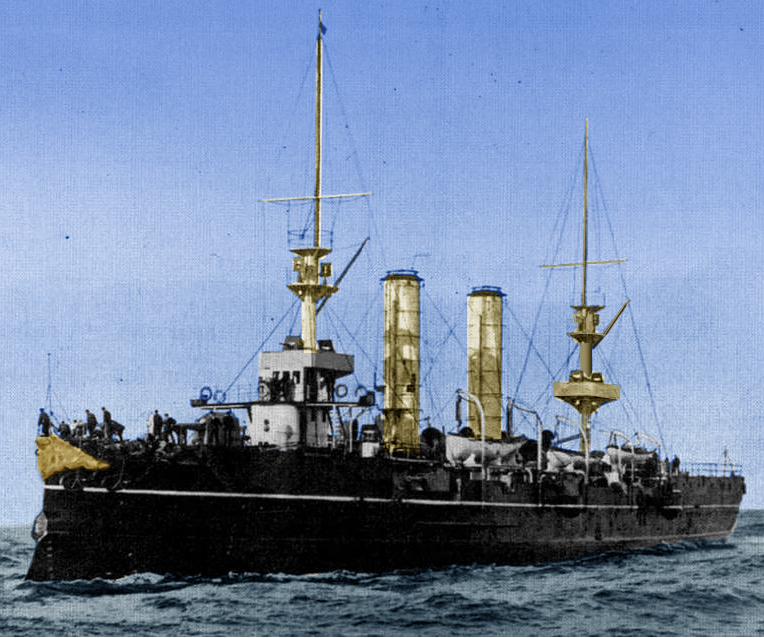
But what was worth Ministro Zenteno ? She was a reasonable 20-knots protected cruiser armed with eight 152mm/40 Armstrong guns, much smaller than the previous Esmeralda and Encalada. She was mostly there to surpass Argentina in numbers, which just obtained ARA Buenos Aires. She had a cushy, unremarkable career marked by the Pan-American Conference in Mexico in 1901, until decommissioned in 1930. Sister ships USS New Orleans and Albany were even scrapped earlier. #ww1 #chileannavy #armadadechile #ministrozenteno
⚙ The naval Arms Race | |
 Armada de Argentina Armada de Argentina |  Armada de Chile Armada de Chile |
| Libertad class (BB) 1887 Veinticinco de Mayo (PC) 1890 Nueve de Julio (PC) 1891 Buenos Aires (PC) 1894 Garibaldi (AC) 1895 San Martín (AC) 1896 Pueyrredón (AC) 1897 General Belgrano (AC) 1898 Rivadavia, Moreno* (AC) 1901 |
Capitán Prat (BB*) 1887 Presidente Errázuriz (PC) 1887 Presidente Pinto (PC) 1887 Blanco Encalada (PC) 1892 Esmeralda (AC) 1894 Ministro Zenteno (PC) 1894 O'Higgins (AC) 1896 Constitución class (BB) 1901 Chacabuco (PC) 1901 |
In November 1894, the Brazilian government placed an order for three protected cruisers with Armstrong, Mitchell & Co Yard in Britain. The first was laid down as Chacabuco on 6 May 1895 at Armstrong’s Elswick. However the government failed to secure the first installment and the yard had the construction delayed so it was instead sold to the Chile by September 1895. She was launched as CNS Ministro Zenteno, on 1 February 1896. Brazil would eventually had one of these, Almirante Barroso, Amazonas being sold to the US and becoming USS New Orleans and Almirante Abreu became USS Albany as tension grew with Spain over Cuba. So, the Chilean cruiser was an undesired opportunity. There were no specifications for her.
Design of the class
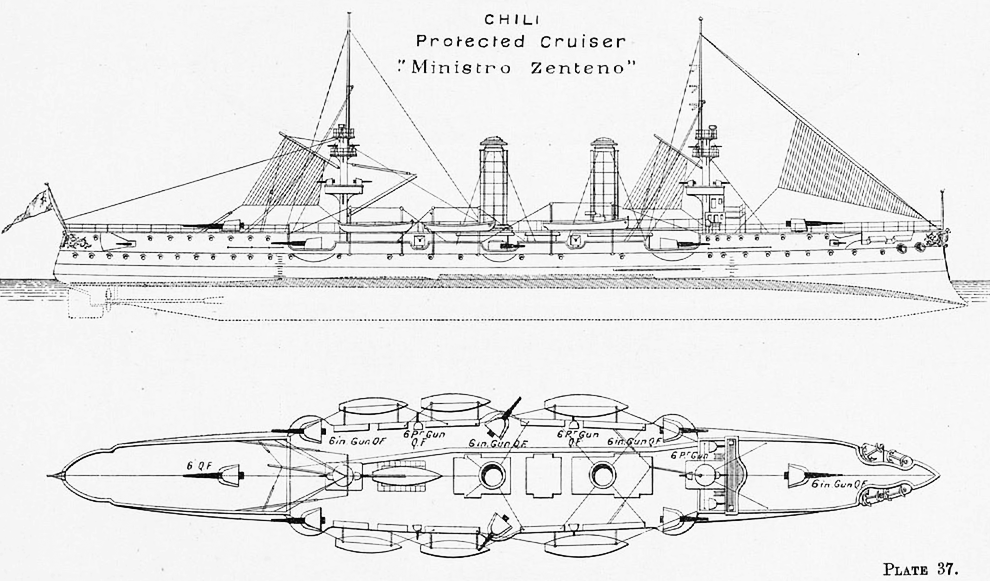
She was a fairly straithforward medium sized protected cruiser with a homogeneous main armamament unlike behemoths like Esmeralda or Blanco Encalada. Symmetrical in appearance, with a forecastle and poop, lower gun battery where were located the other four main guns and two lighter ones on either side. Two military masts with three tops (fighting and spotting) and rigging as shown on Brassey’s depiction. Two equal size vertical funnel, heavenly spaced. Six service boats under davits.
Hull and general design
CNS Ministro Zenteno displaced 3,473 long tons (3,529 t) -standard apparently- and she had a hull 108.00 metres (354 ft 4 in) long overall, 100.58 metres (330 ft) between perpendiculars. For her beam was 43 feet 9 inches (13.34 m) this gave her a good hull ratio close to 1/10. She had a draught of 5.14 metres (16 ft 10 in).
Armour protection layout
She had a full-length arched (“turtle”) deck, all steel armour and 3+1⁄2 inches (89 mm) thick on slopes but down to 1+1⁄4 inches (32 mm) on the flat section. No belt as this armoured deck played that part. There were no bulkheads. Apart this, The ship had a conning tower forward with 4 inches (100 mm) walls, located just below and forward of the bridge. The thickness of shields for the main and secondary guns is unknown, but assumed to be 1-in (25 mm) and below.
Powerplant
She had two propellers, two 3-bladed ones, drived by two vertical triple-expansion steam engines, fed in turn by four boilers, for a grand total of 7,500 indicated horsepower (5,600 kW) in forced draught, trials, but 6,500 indicated horsepower (4,800 kW) in natural draught. Top speed obtained in forced draught on trials was 20.25 knots (23.30 mph; 37.50 km/h) which was not stellar. This means in service and full load she rarely went beyond 19 kts for short period of times and in ideal conditions. She could carry 850 tons oil in normal conditions, but range is unknown.
Armament
Main guns: Eight 6-in (152 mm)/45 QF Elswick guns: Forecastle and poop, centerline, then three either beam, sponsoned, all shielded. Specs as the standard 152/40 Armstrong W Type.
Secondary armament:
-Ten 6-pdr (57mm), Four in casemates bow and stern, four battery deck, two in the wings. Standard Hotchkiss QF type.
-Four 3-pdr (47mm) guns. Located in the fighting tops. Standard 23 caliber QF Hotchkiss Type.
Torpedoes: Three 18-inch (450mm) torpedo tubes: One bow, fixed, two on swivelling mounts, broadside, all surfaced.
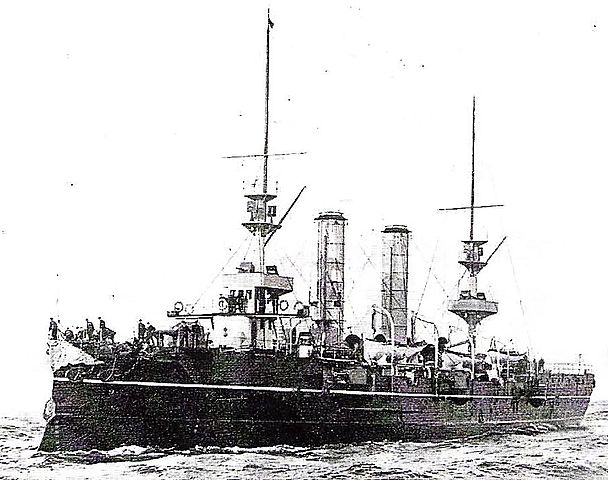

⚙ Ministro Zenteno specifications |
|
| Displacement | 3,437 tons |
| Dimensions | 100.6 x 13.3 x 5.2 m (330 ft 1 in x 43 ft 8 in x 17 ft) |
| Propulsion | 2 VTE, 8 cyl. boilers shp 7,500 |
| Speed | 20.2 knots (37.4 km/h; 23.2 mph) |
| Range | 850 t oil, unknown. |
| Armament | 8× 6-in/40, 10× 3-pdr/40, 1× pdr/23 Hotchkiss, 3x 18-in TTs |
| Protection | Armoured Deck 32-89 mm (1.3 in-3.5 in), CT 102 mm (4 in) |
| Crew | 317 |
CNS Ministro Zenteno in service

CNS Ministro Zenteno entered service in 1898, no known date. She sailed to Chile and started her service in training in home waters. Nothing notable nut she joined the Evolution Squad. She made several trips abroad. By August 1901 she was sent to Mexico under the command of Captain José María Villarreal for the duration of the Pan-American Congress.
Her attending to the Pan-American Conference was linked to the organizion by the US state secretary Blaines, of a trade agreement to clos ties between the United States and southern counterparts, and open Latin American markets to US trade. During the trip she made a stopover in El Callao and Guayaquil, where she stayed on September 18-19 receiving an extraordinary welcome from the Government and population. After the Pan American Congress, she visited Costa Rica, El Salvador, Nicaragua and Guatemala.
Nothing notable in 1902-1907 but that year she departed for a very long cruise.
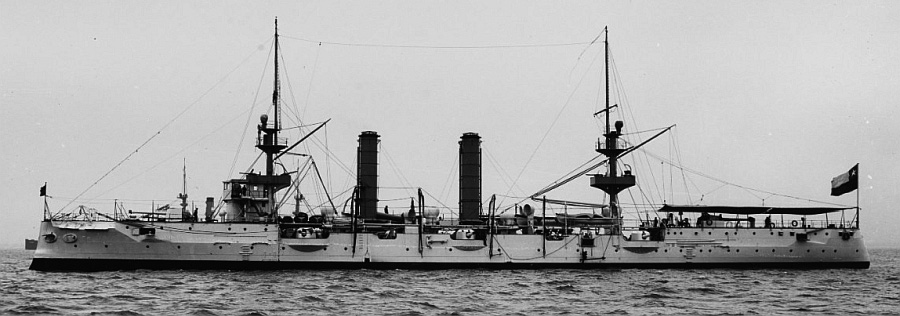
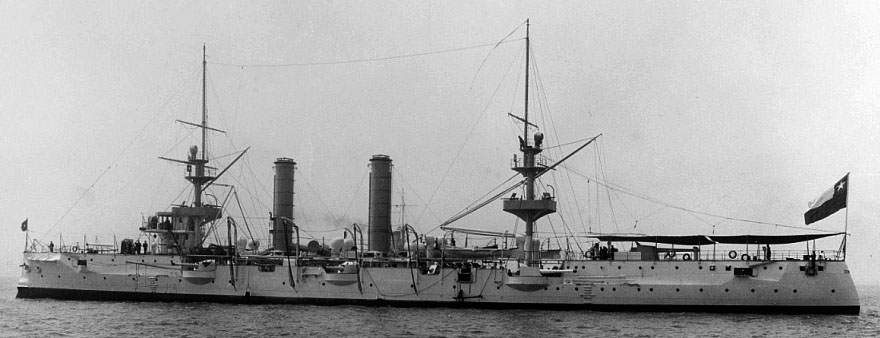
Ministro Zenteno in 1897
She sailed from Valparaíso under command of Captain Arturo E. Wilson on a very special midshipman training cruise, taking advantage of attending the Great International Naval Review in Hampton Roads in Virginia, at the entrance of the bay of Chesapeake,.
So in March 14, 1907, she departed and stopped to Punta Arenas, Bahía, La Guaira, Bermudas, Hampton Roads, Annapolis, Newport, Plymouth, Brest, El Ferrol, Lisboa, Argel, Malta, Spezia, Genova, Barcelona, Cartagena, Gibraltar, Santa Cruz de Tenerife, Río de Janeiro, Buenos Aires, Puerto Madryn, Punta Arenas, Puerto Montt, Talcahuano. She also stopped at Puerto Barroso, Grappler, Dixon, Fortescue, Tamar, Puerto Bueno, Puerto Edén, Puerto Laguna, Melinka, and dropped anchor back in Valparaíso by December 8 the same year.
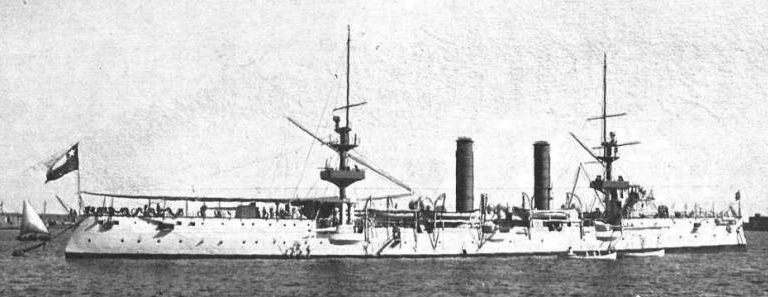
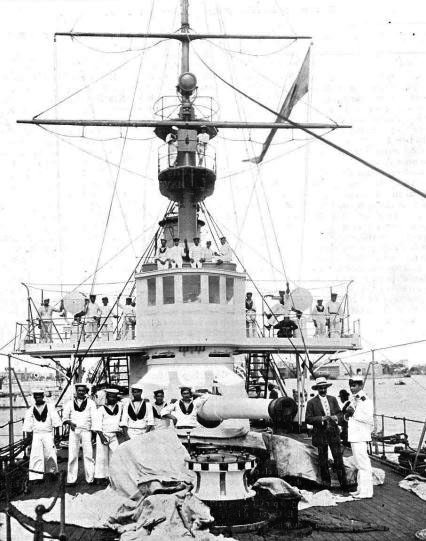

Ministro Zenteno in Barcelona, 1907
Nothing notable between 1908 and WW1. She kept patrolling Chilean waters during the war. Apart some periods of reduced commission, she made also a few trips of hydrographic works in the south. The restr was alternated betwene cadet training, battle squadron exercises, and refits. She never was modernized however.
On June 19, 1919, she took part in an Hydrographic mission under the directuon of Commander Hipólito Marchant in the Beagle Channel area, when she went astray on Lennox Island, loosing men thrown overboard, and causing alarm. The crew requested authorization to lower a boat and despite the bad weather, disembarked in Lennox, went on searching for the unfortunate cabin boys missing. After searching for more than ten hours without sleep, enduring low temperatures and snow, they eventually found Baeza, exhausted but alive. Requiring medical help from the cruiseer, the cutter “Yañez” was dispatched, its Commander skilfully avoiding rocks and managed to rescue all the expedition members. The tugboat “Yánez” carried also a body on board Zenteno, which was identified as second Sailor Idelfonso Ormeño Bravo in help of Baeza. A small island was named Ormeño in homage.

Ministro Zenteno, centennial of Chile, 1910
The cruiser saw little service in the 1920s, being partly decommissioned by Supreme Decree on January 3, 1930. She was sold for BU soon after.
Read More
Links
en.wikipedia.org cruiser_Ministro_Zenteno_(1896)
on navypedia.org
history.navy.mil/our-collections/
armada.cl/
flickr.com
envisitadecortesia.com/tag/ministro-zenteno/
tynebuiltships.co.uk/
m.facebook.com
repositorioarchivohistorico.armada.cl/
shipsnostalgia.com/media/ministro-zenteno.410293/
laststandonzombieisland.com
web.archive.org armada.cl/



 Latest Facebook Entry -
Latest Facebook Entry -  X(Tweeter) Naval Encyclopedia's deck archive
X(Tweeter) Naval Encyclopedia's deck archive Instagram (@navalencyc)
Instagram (@navalencyc)





 French Navy
French Navy Royal Navy
Royal Navy Russian Navy
Russian Navy Armada Espanola
Armada Espanola Austrian Navy
Austrian Navy K.u.K. Kriegsmarine
K.u.K. Kriegsmarine Dansk Marine
Dansk Marine Nautiko Hellenon
Nautiko Hellenon Koninklije Marine 1870
Koninklije Marine 1870 Marinha do Brasil
Marinha do Brasil Osmanlı Donanması
Osmanlı Donanması Marina Do Peru
Marina Do Peru Marinha do Portugal
Marinha do Portugal Regia Marina 1870
Regia Marina 1870 Nihhon Kaigun 1870
Nihhon Kaigun 1870 Preußische Marine 1870
Preußische Marine 1870 Russkiy Flot 1870
Russkiy Flot 1870 Svenska marinen
Svenska marinen Søværnet
Søværnet Union Navy
Union Navy Confederate Navy
Confederate Navy Armada de Argentina
Armada de Argentina Imperial Chinese Navy
Imperial Chinese Navy Marinha do Portugal
Marinha do Portugal Mexico
Mexico Kaiserliche Marine
Kaiserliche Marine 1898 US Navy
1898 US Navy Sovietskiy Flot
Sovietskiy Flot Royal Canadian Navy
Royal Canadian Navy Royal Australian Navy
Royal Australian Navy RNZN Fleet
RNZN Fleet Chinese Navy 1937
Chinese Navy 1937 Kriegsmarine
Kriegsmarine Chilean Navy
Chilean Navy Danish Navy
Danish Navy Finnish Navy
Finnish Navy Hellenic Navy
Hellenic Navy Polish Navy
Polish Navy Romanian Navy
Romanian Navy Turkish Navy
Turkish Navy Royal Yugoslav Navy
Royal Yugoslav Navy Royal Thai Navy
Royal Thai Navy Minor Navies
Minor Navies Albania
Albania Austria
Austria Belgium
Belgium Columbia
Columbia Costa Rica
Costa Rica Cuba
Cuba Czechoslovakia
Czechoslovakia Dominican Republic
Dominican Republic Haiti
Haiti Hungary
Hungary Honduras
Honduras Estonia
Estonia Iceland
Iceland Eire
Eire Equador
Equador Iran
Iran Iraq
Iraq Latvia
Latvia Liberia
Liberia Lithuania
Lithuania Mandchukuo
Mandchukuo Morocco
Morocco Nicaragua
Nicaragua Persia
Persia San Salvador
San Salvador Sarawak
Sarawak Uruguay
Uruguay Venezuela
Venezuela Zanzibar
Zanzibar Warsaw Pact Navies
Warsaw Pact Navies Bulgaria
Bulgaria Hungary
Hungary

 Bundesmarine
Bundesmarine Dutch Navy
Dutch Navy Hellenic Navy
Hellenic Navy Marina Militare
Marina Militare Yugoslav Navy
Yugoslav Navy Chinese Navy
Chinese Navy Indian Navy
Indian Navy Indonesian Navy
Indonesian Navy JMSDF
JMSDF North Korean Navy
North Korean Navy Pakistani Navy
Pakistani Navy Philippines Navy
Philippines Navy ROKN
ROKN Rep. of Singapore Navy
Rep. of Singapore Navy Taiwanese Navy
Taiwanese Navy IDF Navy
IDF Navy Saudi Navy
Saudi Navy Royal New Zealand Navy
Royal New Zealand Navy Egyptian Navy
Egyptian Navy South African Navy
South African Navy






























 Ukrainian Navy
Ukrainian Navy dbodesign
dbodesign